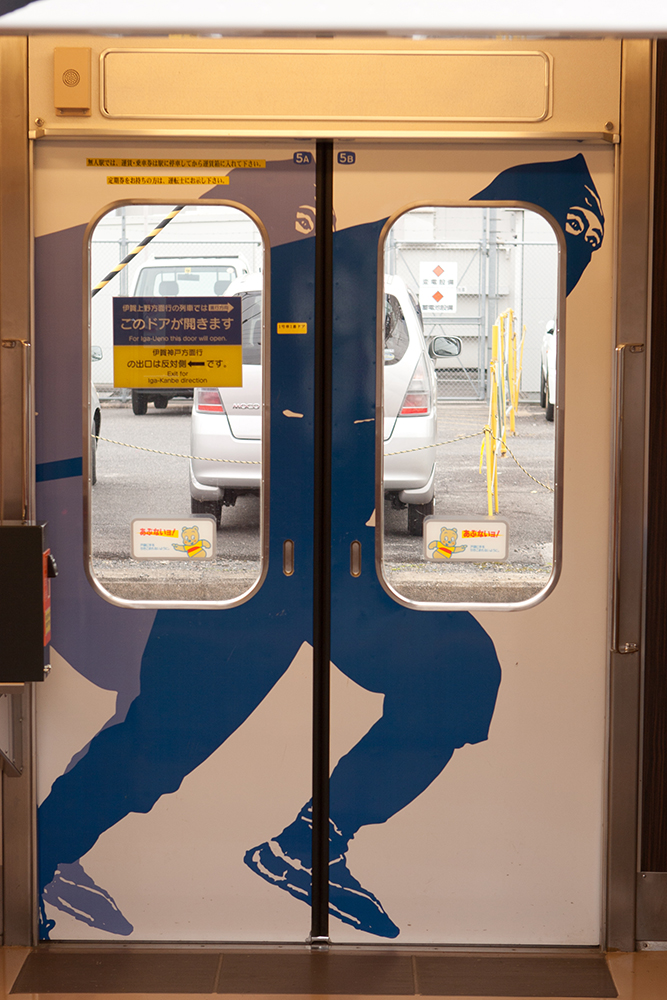Iga City was formed in 2004 from a handful of towns (and one city) in Mie Prefecture, but is still commonly referred to as Iga Ueno: Ueno was the city, and to distinguish it from the identically-named district of Tokyo it was usually called Iga Ueno, as Iga was the next largest town.
Famous as the birthplace of the Iga-ryū, the Iga school of Ninjutsu, Iga City is home to the magnificent Ninja Museum (which I’ll cover in Friday’s post), but the museum isn’t the only reason to visit. The region is renowned across Japan for local produce including rice, beef and sake, and for its traditional crafts: Iga Yakimono, or ceramic ware, is highly valued for tea ceremony utensils; and Iga Kumihimo are braided silk cords which are often used as sashes in kimono and coats, but were once vital for threading pieces of samurai armour together.
The region was also the birthplace of Matsuo Bashō, although the exact location is only speculated upon. Japan’s most highly-regarded Haiku and Renku Master had itchy feet, and travelled the country at a time when doing so was fraught with danger. Today Iga City has a memorial hall (the Haiseiden) containing a ceramic statue of Bashō which is only open to public viewing during the annual Bashō festival on the 12th of October.
The city fully embraces its Ninja heritage. People paint murals on their own shutters – garage and storefront alike. This Ninja Dog had to be my favourite.
And how about some bollards? Nobody really wants dreary bollards, do they? A necessity, yes, but do they have to be so dull? Well, no! Not in Iga they don’t.
It wouldn’t really be me if I didn’t talk about trains at some point (consider yourself warned: I like trains a lot – you’re going to see much more of them in the future on this blog). The Iga Tetsudo Iga Line (formerly the Kintetsu Iga Line) is the only way to reach Iga City by train, but it’s bloody great! Why?
Ninjas. That’s why.
Yep, you can get to Iga City on a NINJA TRAIN! There is plainer rolling stock on the line, but those are also awesome because they’re classic rolling stock that have been in use on this little line for decades. Even better, these trains were designed by Matsumoto Reiji, creator of Space Battleship Yamato, and the line has it’s own mascot – a blue and white owl named Fukunin.
Oooh! Deep breath, Troo! It’s okay!
Visiting Iga City:
Getting to Iga City takes dedicated effort. You need to get onto the Iga Tetsudo Iga Line from either JR Iga-Ueno Station on the JR Kansai Line, or Kintetsu Iga-Kambe Station on the Kintetsu Osaka Line. Either way, there is only one train per hour on the Iga Tetsudo Iga Line, and while this is a beautiful region and your views from the train will be stunning, you might be sitting on a platform for 55 minutes waiting for it.
Consider using the Kintetsu Osaka Line if it’s feasible for you, because at least at Kintetsu Iga-Kambe station there is an Omiyage shop selling Fukunin and ninja decorated items, as well as unique models of the rolling stock. It’s slower than the JR line, but at least you will have something to do while waiting at Iga-Kambe. Either way this is a long travel time for such a short journey, so allow up to three hours if you are coming from Osaka. Only Express and Semi-Express services stop at Iga-Kambe.
From Kyoto on the JR Line, take the JR Nara Line to Kizu and switch to the JR Kansai Line to Iga-Ueno. Five minutes into this second trip you will need to switch trains at Kamo Station. The journey takes just under two hours. Travelling from Nara also necessitates a switch at Kamo.
Once on the Iga Tetsudo Iga Line, disembark at Ueno-shi Station.
If you are coming from Tokyo, you will need to bounce through Nagoya. This isn’t a short hop – even from Nagoya it can be up to three hours of travel time. If you can (shame on you!) pass on the trains and want to travel more quickly, consider the Mie Kotsu Highway Bus from the Meitetsu Bus Centre in Nagoya. It takes under two hours, but leaves infrequently – every 2-3 hours. Check with the Bus Centre for the timetable.








Wow, I REALLY want to go there! So interesting, thanks!
Pingback: Ninja Museum of Igaryu, Iga City, Japan | Troo Adventure
Oh man, I really want to go back to Japan…
It’s addictive, isn’t it? 😀
Pingback: How to use the trains in Japan | Troo Adventure